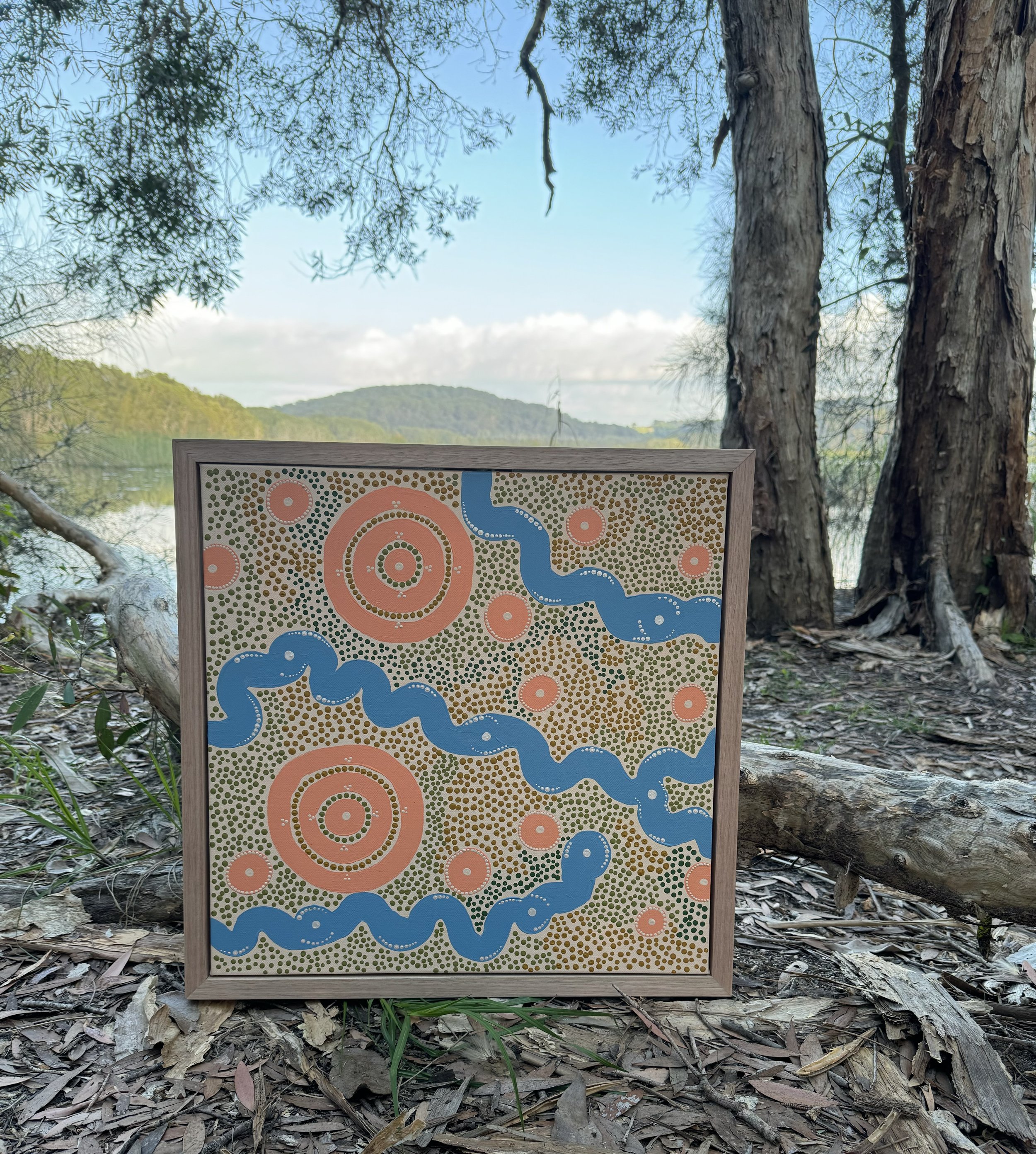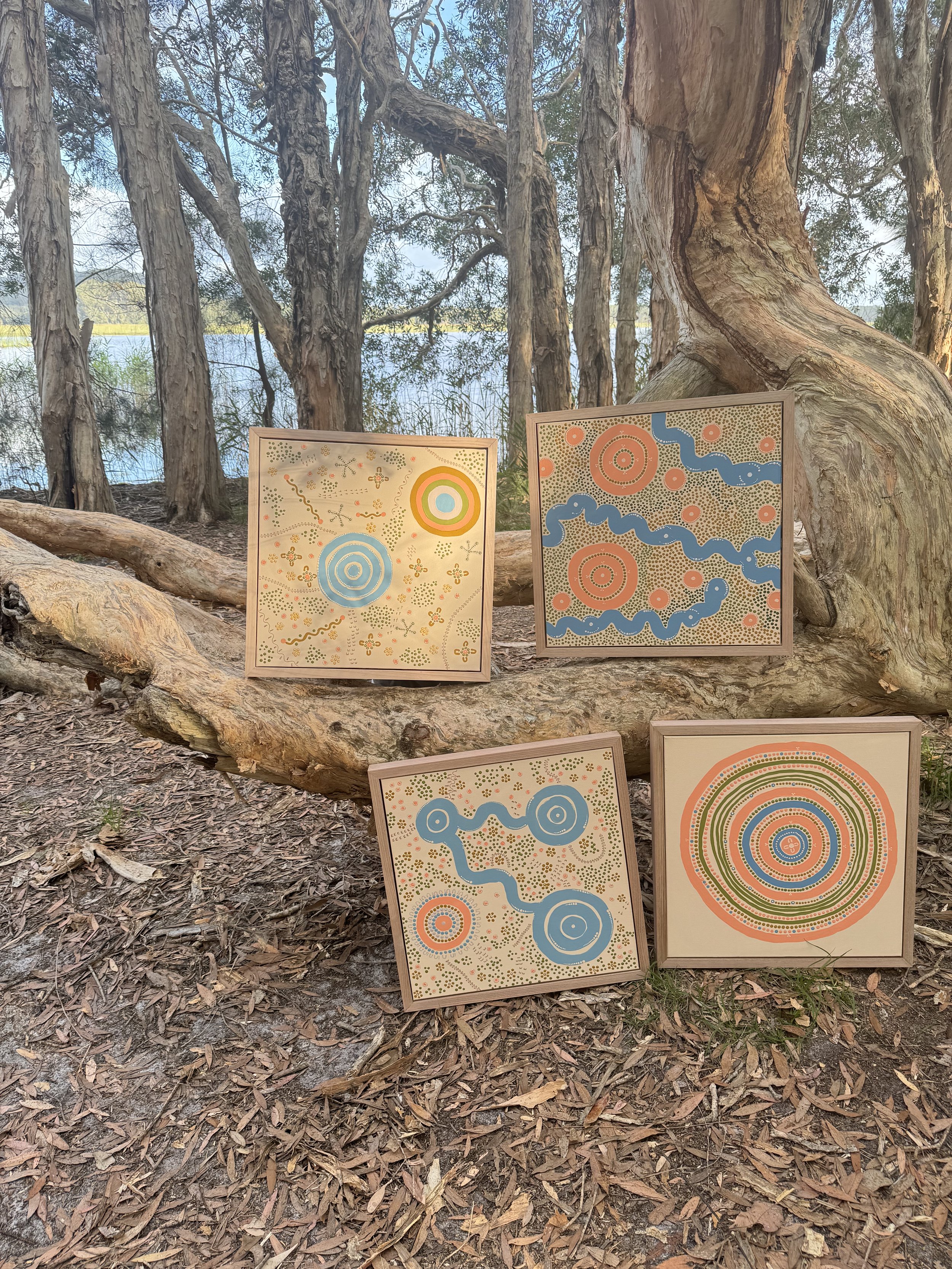 Image 1 of 3
Image 1 of 3

 Image 2 of 3
Image 2 of 3

 Image 3 of 3
Image 3 of 3




People of the three rivers
The name Wiradjuri means, 'people of the three rivers'. This piece represents the abundance that the rivers (Lachlan, Murrumbidgee and Macquarie) provided for our people.
The blue waved lines represent the three rivers of the Wiradjuri people, the small Circles with a small boarder of light coloured dots are camp sites which are across our Country showing fruitful travel and safety. The two larger circle are the main tribe from which people who travelled originally came from. the dots surrounding the lands depict the bush lands.
Wiradjuri, meaning "people of the three rivers," is a piece that embodies the deep connection between the Wiradjuri people and the land—specifically the three great rivers that have been the lifeblood of their culture, sustenance, and identity: the Lachlan, Murrumbidgee, and Macquarie. These rivers are not just waterways; they represent the source of life, the sustenance that has fed the people for generations, and the spiritual and physical connection that binds the community together. This artwork is a visual tribute to the abundance these rivers provided, as well as the journeys the Wiradjuri people undertook, their traditions, and the landscapes they navigated in harmony with the flow of the rivers.
At the heart of the piece are the blue waved lines, which represent the three rivers that flow through Wiradjuri country. Each wave is not just a literal representation of water but also a symbol of the journey—of life’s ebb and flow, and the paths taken by the people through their land. The blue evokes the vitality of water, the source of life, and the rhythmic, flowing nature of the rivers themselves. The waves also hint at the interconnectedness of the rivers and the land, signifying how the rivers are the arteries that feed the heart of the Wiradjuri people, providing sustenance, transportation, and spiritual connection.
The small circles scattered throughout the piece, each surrounded by a delicate border of light-coloured dots, represent the campsites of the Wiradjuri people scattered across their country. These campsites are places of rest, reflection, and community, where travellers gather after their journeys along the rivers. The light-coloured dots surrounding the small circles reflect the safety and protection offered at these sites, as well as the abundance and fruitfulness of the land. These dots signify the gathering of resources, the fertile grounds that sustain life, and the community’s connection to the land’s offerings. The campsites are markers of safe travel, each one representing a stop along the way where people could find rest, share stories, and continue their journeys in harmony with the land.
The two larger circles in the artwork represent the main tribe—the central hub from which the people of Wiradjuri country originally came. These circles symbolise the strength and unity of the tribe, the heart from which all journeys and travels across the land began. These larger circles also stand as cultural hubs, places of gathering and connection, where the wisdom of the elders is passed down and the stories of the ancestors are shared. The positioning of the larger circles highlights the tribe’s central role in the life of the Wiradjuri people, with the smaller circles (campsites) connecting and radiating outward, forming the greater network of community and connection across the country.
The dots surrounding the lands are symbolic of the bush lands—the rich and thriving ecosystems that envelop the rivers and the campsites. These green dots represent the bushland's abundance, the natural resources that provide food, shelter, and materials for the Wiradjuri people. They also reflect the diversity and interconnectedness of the land—how the bush is a living, breathing entity that sustains all life. The green represents growth, fertility, and renewal, highlighting the crucial role the bush lands play in the ongoing cycle of life for the Wiradjuri people. These dots form a network that connects the rivers, campsites, and the people, underscoring the interdependence of the waterways, the land, and the tribe.
Together, the various elements of the painting—rivers, campsites, tribal centres, and bush lands—weave a story of abundance, community, and journey. The piece speaks to the sustainability of the Wiradjuri people’s relationship with the land, emphasising how the rivers provided not only physical sustenance but also the spiritual and cultural framework that supported their way of life. It’s a reminder of the deep connection between the people, the land, and the waterways, and the ongoing journey of the Wiradjuri people as they continue to walk the land their ancestors walked, honouring the teachings and abundance passed down through generations.
This Piece is an Original, there is only one and will not be repeated.
500mm x 500mm including the frame
Framed in Tasmanian Oak
Colours & timber frame may differ in person. This is not considered a fault.
The name Wiradjuri means, 'people of the three rivers'. This piece represents the abundance that the rivers (Lachlan, Murrumbidgee and Macquarie) provided for our people.
The blue waved lines represent the three rivers of the Wiradjuri people, the small Circles with a small boarder of light coloured dots are camp sites which are across our Country showing fruitful travel and safety. The two larger circle are the main tribe from which people who travelled originally came from. the dots surrounding the lands depict the bush lands.
Wiradjuri, meaning "people of the three rivers," is a piece that embodies the deep connection between the Wiradjuri people and the land—specifically the three great rivers that have been the lifeblood of their culture, sustenance, and identity: the Lachlan, Murrumbidgee, and Macquarie. These rivers are not just waterways; they represent the source of life, the sustenance that has fed the people for generations, and the spiritual and physical connection that binds the community together. This artwork is a visual tribute to the abundance these rivers provided, as well as the journeys the Wiradjuri people undertook, their traditions, and the landscapes they navigated in harmony with the flow of the rivers.
At the heart of the piece are the blue waved lines, which represent the three rivers that flow through Wiradjuri country. Each wave is not just a literal representation of water but also a symbol of the journey—of life’s ebb and flow, and the paths taken by the people through their land. The blue evokes the vitality of water, the source of life, and the rhythmic, flowing nature of the rivers themselves. The waves also hint at the interconnectedness of the rivers and the land, signifying how the rivers are the arteries that feed the heart of the Wiradjuri people, providing sustenance, transportation, and spiritual connection.
The small circles scattered throughout the piece, each surrounded by a delicate border of light-coloured dots, represent the campsites of the Wiradjuri people scattered across their country. These campsites are places of rest, reflection, and community, where travellers gather after their journeys along the rivers. The light-coloured dots surrounding the small circles reflect the safety and protection offered at these sites, as well as the abundance and fruitfulness of the land. These dots signify the gathering of resources, the fertile grounds that sustain life, and the community’s connection to the land’s offerings. The campsites are markers of safe travel, each one representing a stop along the way where people could find rest, share stories, and continue their journeys in harmony with the land.
The two larger circles in the artwork represent the main tribe—the central hub from which the people of Wiradjuri country originally came. These circles symbolise the strength and unity of the tribe, the heart from which all journeys and travels across the land began. These larger circles also stand as cultural hubs, places of gathering and connection, where the wisdom of the elders is passed down and the stories of the ancestors are shared. The positioning of the larger circles highlights the tribe’s central role in the life of the Wiradjuri people, with the smaller circles (campsites) connecting and radiating outward, forming the greater network of community and connection across the country.
The dots surrounding the lands are symbolic of the bush lands—the rich and thriving ecosystems that envelop the rivers and the campsites. These green dots represent the bushland's abundance, the natural resources that provide food, shelter, and materials for the Wiradjuri people. They also reflect the diversity and interconnectedness of the land—how the bush is a living, breathing entity that sustains all life. The green represents growth, fertility, and renewal, highlighting the crucial role the bush lands play in the ongoing cycle of life for the Wiradjuri people. These dots form a network that connects the rivers, campsites, and the people, underscoring the interdependence of the waterways, the land, and the tribe.
Together, the various elements of the painting—rivers, campsites, tribal centres, and bush lands—weave a story of abundance, community, and journey. The piece speaks to the sustainability of the Wiradjuri people’s relationship with the land, emphasising how the rivers provided not only physical sustenance but also the spiritual and cultural framework that supported their way of life. It’s a reminder of the deep connection between the people, the land, and the waterways, and the ongoing journey of the Wiradjuri people as they continue to walk the land their ancestors walked, honouring the teachings and abundance passed down through generations.
This Piece is an Original, there is only one and will not be repeated.
500mm x 500mm including the frame
Framed in Tasmanian Oak
Colours & timber frame may differ in person. This is not considered a fault.